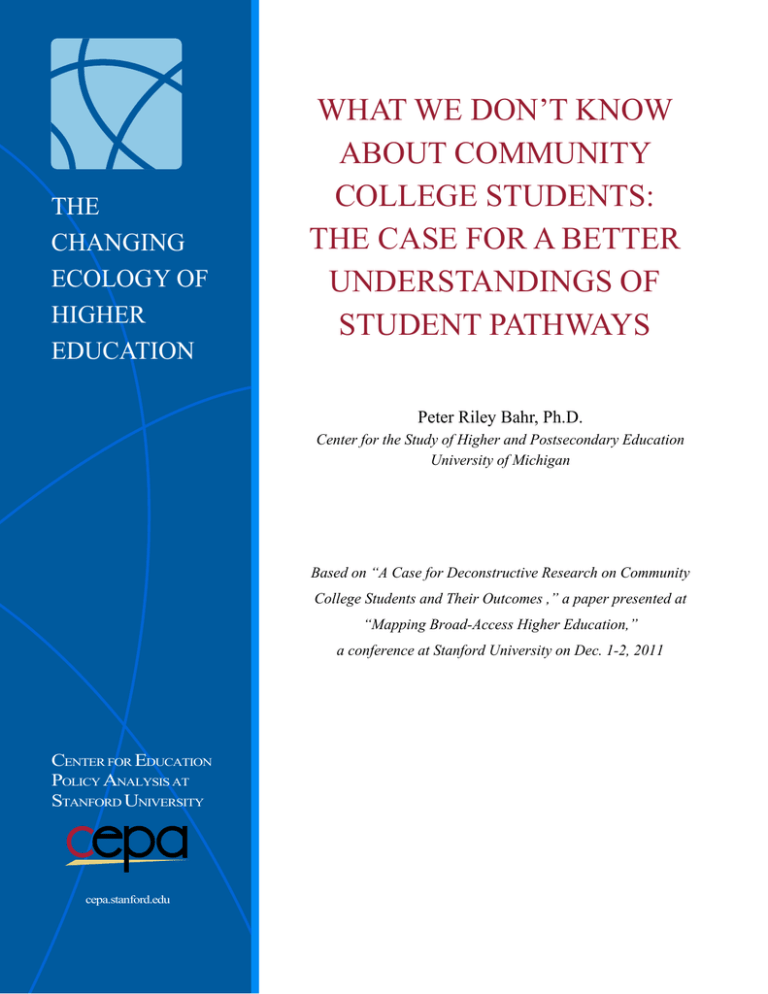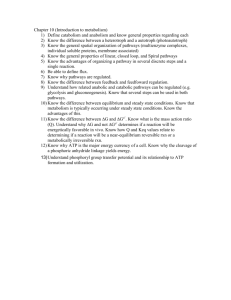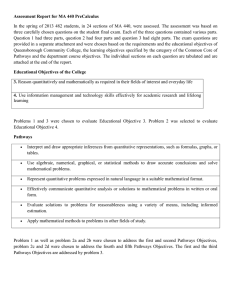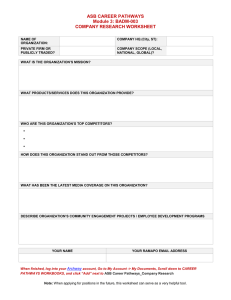WHAT WE DON’T KNOW ABOUT COMMUNITY COLLEGE STUDENTS: THE CASE FOR A BETTER
advertisement

The Changing Ecology of Higher Educa on THE CHANGING ECOLOGY OF HIGHER EDUCATION WHAT WE DON’T KNOW ABOUT COMMUNITY COLLEGE STUDENTS: THE CASE FOR A BETTER UNDERSTANDINGS OF STUDENT PATHWAYS Peter Riley Bahr, Ph.D. Center for the Study of Higher and Postsecondary Education University of Michigan Based on “A Case for Deconstructive Research on Community College Students and Their Outcomes ,” a paper presented at “Mapping Broad-Access Higher Education,” a conference at Stanford University on Dec. 1-2, 2011 CENTER FOR EDUCATION POLICY ANALYSIS AT STANFORD UNIVERSITY cepa.stanford.edu 1 What We Don’t Know about Community College Students: The Case for a Be er Understanding of Student Pathways Recently, the national discourse on postsecondary education has focused on efforts to increase rates of certificate and degree completion. This call has been particularly strong at open-access institutions—those colleges and universities that admit the vast majority of applicants. This discussion, however, has paid little attention to the diverse pathways that students take through these institutions—for example, students’ course-taking and enrollment patterns, and use of support services—and the influence of students’ pathways on whether they ultimately graduate. In fact, the diversity of student pathways in community colleges is enormous (and unusual even among broad-access institutions) due to varying institutional missions and goals of students who attend them. Yet the wide variety of student pathways in community colleges and the influence of these pathways on student outcomes remain a proverbial black box for policymakers, administrators, and faculty. As a result, our capacity to improve student completion rates through effective student supports and other interventions is sorely limited. The traditional approach to understanding community college students and their outcomes has been dominated by relatively simple analyses of the relationships between pre- or early-college student characteristics and outcomes such as dropping out of college or completing a credential. In this brief, I argue for a shift in focus in community college research to the pathways that students select while in college and the relationships between these pathways and student outcomes. This shift will require a deconstructive approach that draws upon both quantitative and qualitative research. Quantitative deconstructive research will disaggregate the steps in student pathways through the community college and answer questions about how students progress from college entry to college exit, when key decision points occur, and who selects which pathway. Qualitative deconstructive research will answer questions about why students make the decisions that they do, providing insight into students’ understanding of key decision points and the meanings that they attribute to their choices. Coordination of the two bodies of work will ensure that they are mutually informative: the findings of 2 A gap in our current knowledge: What are the dominant student pathways through community colleges, and how do these pathways influence student outcomes? Current research does not reveal much about the variety of pathways that students take through community colleges, nor much about the relationships between these pathways and students’ eventual college outcomes. As a result, our capacity to develop effective interventions that improve student completion rates is limited. What are student pathways? In this brief, student pathways are defined as the term-by-term steps or stages through which students pass between enrolling in and departing from college. The term pathway encompasses student course-taking behavior; enrollment patterns; course outcomes; choice of program of study; use of advising, tutoring, and other support services; and a variety of other features that ultimately determine long-term student outcomes, such as whether they complete a postsecondary credential. In turn, students’ pathways are influenced by still other factors, such as their age, sex, marital status, living situation, parenting responsibilities, employment, and commute distance. Such factors are important to take into account when studying broadaccess colleges, including community colleges, because the majority of these students do not exhibit the profile of traditional college students (e.g. young, unmarried, living on-campus). Recommendation: Change the dominant research paradigm from a focus on outcomes to a focus on pathways. Policymakers, administrators, and faculty need access to information about the nature of the pathways that students select in community colleges and the relationship between these pathways and subsequent outcomes. Existing research on The Changing Ecology of Higher Educa on community college students tends to focus on the relationships between the factors that influence pathway choices (e.g., age, living situation) and longterm student outcomes, neglecting the pathways themselves, which obscures how particular pathway choices influence subsequent outcomes. That is, student pathways are treated as a mysterious blackbox: students enter college with a given set of characteristics and exit college with or without a credential, but the term-by-term decisions and experiences of students between entry and exit remain largely a mystery. This brief advocates for a “deconstructive approach” to the study of community college student pathways. Such an approach draws upon both transcript-level quantitative data and rich qualitative data to deconstruct student pathways and elaborate the relationships between various pathways and outcomes of interest, such as successful remediation of skill deficiencies, credential completion, and transfer to a four-year institution. This approach represents a shift from the current focus on outcomes that has dominated research on community college students to a focus on students’ progression through community college. quantitative deconstructive research must inform the questions that are asked in subsequent qualitative studies, and vice versa. The Traditional Approach to Research on Community College Students The traditional approach to research on community college student outcomes is dominated by fairly simple input-output analyses, in which a given outcome is measured as a function of a set of pre- or early -college student characteristics. Depending on the focus of the study, common pre- or early-college characteristics may include race/ethnicity, sex, age, socioeconomic status, marital status, living situation, parenting responsibilities, employment, assessment scores in high school, placement scores in college, or academic goal at college entry. Through the use of regression models, the researcher seeks to understand the association between these pre- or early-college student characteristics and the outcome of interest. Between college entry and exit, however, students must successfully navigate college. In doing so, they make a wide range of choices about the pathways that they will take. For example, students who enroll fulltime, know their intended major, and receive solid academic advising will likely have a very different community college experience than students who enroll part-time because of family obligations, explore coursework in a number of different possible major areas, and receive no guidance. In fact, community colleges allow tremendous flexibility with respect to student pathways. Except in some career-oriented and impacted programs, such as nursing, community college students typically have great latitude to: pursue a credential or not, come and go from the institutions from term to term, attend part-time or full-time, declare a major late or not at all, modify their academic objectives, enroll in any courses in any program of study if they meet the prerequisites, and participate in tutoring or advising programs, or not. Students have responded to this flexibility with a complex array of sometimes-meandering paths into, through, and out of college. One could argue that such divergent pathways are the most important variables in an analysis of student outcomes because these pathways link students’ characteristics and circumstances at college entry and their eventual outcomes. As an analytical “nod” to these numerous and varied pathways, researchers often include a small set of mediating variables in their models to 3 What We Don’t Know about Community College Students: The Case for a Be er Understanding of Student Pathways describe in a very limited fashion what students did between college entry and eventual college exit. These variables might include enrolling part-time versus fulltime in the first semester of college, enrolling in a remedial course in the first year of college, or total duration of enrollment (number of semesters or quarters) in college, but do not fully capture the nuance of a full college pathway. This traditional approach has provided important insights about which pre- and early-college characteristics tend to predispose college students to more favorable or less favorable outcomes. However, the oversimplified set of mediating variables used to represent student pathways cannot capture the complexity of students’ actual behavior between college entry and exit. Consequently, this approach has provided comparatively little insight about how students move through college and how their choices are related to eventual outcomes. That is, students’ complex pathway choices, and the relationships between these choices and students’ outcomes, remain relatively opaque for policymakers and college leaders. In sum, the use of a few mediating variables to “stand in for” or represent student pathways through college can only go so far in faithfully capturing students’ college pathways. This simplification of a highly nuanced phenomenon relies on a host of assumptions about the linearity and uniformity of student behavior that often do not hold up to scrutiny. As a result, the capacity of even the most complex of these models to describe student pathways and to shed light on the influence of those pathways on subsequent outcomes is limited. A Deconstructive Approach: Focusing on the Process of Students’ Progress Leinbach and Jenkins suggest that “understanding how students actually progress through their college programs is essential in developing strategies and choosing appropriate interventions to improve student outcomes.” In other words, once we understand how students’ pathways in college are related to outcomes, policymakers and administrators can design and implement better institutional interventions and practices to improve student attainment. Consequently, as long as student pathways remain uncharted, the development of institutional interventions will be more a product of guesswork than of sound and empirically based reasoning. The best research response to this challenge is a deconstructive one—an idea that is gaining traction in the research community. This deconstructive approach aims to Figure 1. A DeconstrucƟve Research Approach “deconstruct” the constituent parts of QualitaƟve Research QuanƟtaƟve Research students’ college pathways using two interconnected approaches, a AmbiguiƟes in quanƟtaƟve results help to quantitative approach and a qualitative shape qualitaƟve studies approach (see Figure 1). The quantitative approach addresses how 1. Describes student 1. Determine meanings students progress from college entry to pathways through a ributed to choices. college exit, how contextual factors transcript data 2. Elaborate students’ affect students’ choices, how selected choice processes. 2. Relates those pathways to outcomes pathways relate to outcomes, when key decision points in students’ pathways occur, and who is represented The generalizability of qualitaƟve findings are tested in quanƟtaƟve studies disproportionately in each potential pathway. The qualitative approach addresses why students make the 4 The Changing Ecology of Higher Educa on choices and exhibit the behaviors that they do. Answering these types of questions is necessary to drive future research, develop effective interventions, and determine which kinds of interventions are appropriate for influencing pathway decisions and improving student outcomes. The Role of Quantitative Research Using a deconstructive approach, quantitative researchers draw from rich transcript-level data about student course-taking and enrollment behavior in college to identify and “deconstruct” the varied pathways that students take between college entry and a given outcome of interest. The outcome of interest could be, for example, the achievement of college-level math competency, the completion of core coursework in a program of study, the completion of a credential, or upward transfer to a fouryear institution. A deconstructive approach focuses in detail on the process of students’ movement through the steps or stages that lead to a given outcome—students’ intensity of enrollment, the courses they take, and the grades they earn. As an example of the deconstructive approach, my “Deconstructing remediation in the community college” remains one of the few published studies that analyzed in detail the individual steps of the remedial process and the student behaviors associated with each step (see sidebar, “The benefits of a deconstructive approach”). Other studies have also examined remedial education in terms of process rather than outcome, including work by Bailey, Jeong, and Cho and my previous work “Educational attainment as process.” More generally, a number of other researchers have mined transcript-level data about student behaviors, including a growing body of work examining transcriptlevel data in relation to specific outcomes in community colleges. For example, Hagedorn and her colleagues explored students’ progress through the steps of preparation for transfer to a four-year institution. Calcagno, Crosta, Bailey, and Jenkins examined community college students’ milestones on the path to a degree, defined in terms of thresholds of percentage of program completed, thresholds of earned credits, and passing college-level math and writing courses. Roksa and Calcagno extended this work on milestones in their examination of transfer to four-year institutions. Likewise, a related body of work has begun to describe the larger course-taking trajectories of students, and the relationships between these trajectories and student The benefits of a deconstructive approach My “Deconstructing remediation in the community college” provides an illustration of the deconstruction of student behaviors through a careful analysis of transcript-level data, and the value of that effort for understanding how these behaviors unfold over time. In this study, I sought to answer the question of why so few students who begin a remedial sequence in math or writing ultimately achieve college-level competency in the subject, and why students who begin the sequence at lower points of entry suffer such a large disadvantage in this respect. I framed the study as a matter of attrition: when and how are students lost from the remedial sequence? I divided the remedial sequence into the course-taking “steps” through which students must advance in order to achieve college-level competency. I then divided each step into its constituent behaviors: the attempt of a given step in the remedial sequence; the delay of a step; the course outcome (pass or fail) experienced by the student at this step; the attempt of the next step in the remedial sequence; etc. Finally, I analyzed each of these constituent remedial course-taking behaviors as a function of the student’s point of entry to the remedial sequence, the students’ prior remedial course-taking variables (e.g., how does the delay of a given step of the remedial sequence influence the likelihood of attempting the next step in the sequence?), and other relevant variables. 5 What We Don’t Know about Community College Students: The Case for a Be er Understanding of Student Pathways The results indicate that attrition from remedial sequences takes three forms: 1. Skill-specific attrition. Students who begin the remedial sequence at lower points—those who require more courses to complete remediation—are disproportionately likely to make detrimental choices within the overall sequence. The most notable of these choices was the delay of the first math course, which predisposed students to other unfavorable behaviors and outcomes, including delays of subsequent courses and lower rates of success in subsequent courses. 2. Course-specific attrition. Beginning algebra, a course within the remedial math sequence, presented a disproportionately high level of difficulty for students who advanced to this course from a lower point of entry. There was a lower rate of first-attempt success in this course than in any other course in the sequence, and a resulting higher likelihood of attrition from the sequence at this juncture. 3. Escalating nonspecific attrition. There was an increasing rate of loss of students at each step of the remedial course sequence regardless of prior behaviors or course outcomes. This type of attrition, which was evident even among students who had otherwise promising trajectories (such as passing all prior courses in the subject and enrolling in courses in a timely fashion), has the greatest impact on students who begin the sequence at lower points of entry because they needed to complete more steps. These findings provide a number of fruitful directions for policy and practice. For example, the high rate of attrition from remedial math sequences suggests the need for alternative credentialing paths that do not require transfer-level competency in math. Community colleges provide these paths in many vocational certificate programs, but students are having difficulty finding their way to these programs after exiting from the remedial sequence. A reasonable question to ask regarding students’ decisions in this respect is, why? A complete answer to this question will require both further quantitative research and, more importantly, qualitative research that employs, for example, student interviews or focus groups. Qualitative research by Rosenbaum, Rosenbaum, and Stephan (“Removing the BA Blinders: Reconceiving Community College Procedures to Improve Student Success”) has already revealed that community college students often do not receive proper advising, institutions often lack clear program structures, and classes sometimes are offered at times that may be problematic for students who are working or have other responsibilities. These findings draw attention to the many ways in which the organization of an institution may adversely affect student performance in ways that are rarely captured in quantitative studies. Qualitative deconstructive research can greatly enhance our understanding of student pathways and the obstacles that students encounter in their college pathways. outcomes, including my own work “The bird’s eye view of community colleges.” The Role of Qualitative Research Quantitative research holds great promise for describing how students’ pathways unfold, when key decision points occur, and who selects which path, but 6 this type of research is limited with respect to explaining why students exhibit the behaviors that they do. For example, my study (see sidebar) provided evidence of the enormous negative impact of even one non-passing grade in the remedial sequence, even for students who have passed all prior courses in the sequence, but it did not illuminate the reasons why this impact is so large. Why do students who have passed all remedial courses to-date The Changing Ecology of Higher Educa on drop out of the remedial sequence after a single nonpassing grade, even though they often continue to attend college and take other courses? Answering questions of this type requires qualitative research approaches such as student interviews or focus groups. Unfortunately, the fraction of research on community college students that is qualitative in nature is small, and only a portion of that work can be considered mutually informative with respect to the much larger body of quantitative work. In fact, the cyclical analytical process whereby quantitative research informs qualitative research, and vice versa, is largely broken with regard to research on community college students. In the absence of such qualitative work, quantitative researchers are left to speculate about the reasons and causes of observed associations, and this speculation carries over into proposed interventions—to the detriment of the success of those interventions. Without knowing why students respond as they do to a course failure in a remedial sequence, college leaders must rely on expensive, timeconsuming trial-and-error to determine what interventions are needed, what form the interventions should take, and when pathway interventions should be introduced. There are some excellent examples of qualitative research of this sort, though the number of such studies is comparatively small. For example, Rosenbaum, DeilAmen, and Person provided insights into the interaction of institutional structure and student behavior. Likewise, Cox advanced understanding of how students’ subjective experiences of the community college shape their decision-making and behavior. Other examples include work by Townsend and Wilson and Bensimon and Dowd. Combining the Quantitative and Qualitative in Deconstructive Research UltimatelyUltimately, for deconstructive research to be fully informative, qualitative research must be mapped to quantitative research to address ambiguous quantitative findings, and quantitative research must be mapped to qualitative research to examine whether qualitative conclusions can be generalized to larger populations (see Figure 1). Quantitative research using transcript-level data can reveal the nature of students’ varied pathways, the key decision points along these pathways, how pre- and early-college characteristics are related to pathways, and which pathways are more likely to lead to particular desirable outcomes. Qualitative research, drawing on interviews and focus groups, can answer questions about why students follow particular pathways in postsecondary education and make the decisions that they do. However, only through coordination of qualitative and quantitative research efforts will a complete understanding of students’ pathways and the relationship between these pathways and students’ outcomes emerge. Though the two types of research need not be conducted simultaneously, or even by the same researchers, it is important that such research be designed to address the same research questions and to produce corresponding findings. Conclusion: The Direction of Research on Community College Students There is currently a limited amount of deconstructive research on community college pathways, but the recognition of its need is growing. Unfortunately, the larger trend in research on community college students and their outcomes appears to be pointed elsewhere. In the last few years, for example, there has been a proliferation of studies designed to determine whether, in general, community colleges help or hinder students’ attainment. These studies can be traced to Clark’s work on “The ‘cooling out’ function in higher education” and to Karabel’s thesis concerning “Community colleges and social stratification.” Though this recent work offers sophisticated quantitative methods, the question that underlies these studies—Do community colleges help or hinder students’ attainment? —can provide comparatively little information about specific obstacles at community colleges that impede student progress and the appropriate interventions to improve student success. This trend invites one to inquire whether we are asking the most useful and important questions about community college students. 7 What We Don’t Know about Community College Students: The Case for a Be er Understanding of Student Pathways In truth, given how much we know about the associations between community college students’ characteristics and their outcomes, it is remarkable how little we know about the course-taking behaviors and enrollment patterns that connect characteristics to outcomes. This blind spot hinders our capacity to influence those outcomes. By proposing the deconstructive approach described here to understand students’ behaviors and the links between behaviors and outcomes, I call not for more research but rather for different research—to illuminate the how, when, who, and why of students’ pathways though community colleges. This approach will reveal the links between students’ pathways and their eventual outcomes and, thereby, provide useful direction for policymakers and college leaders about how to improve students’ chances of succeeding in college. Full citations are provided in the source document, “A Case for Deconstructive Research on Community College Students and Their Outcomes,” available at: http://cepa.stanford.edu/ecology CENTER FOR EDUCATION POLICY ANALYSIS At Stanford University 520 Galvez Mall, CERAS Building Stanford, CA 94305-3084 Phone: (650) 736-1258 contactcepa@stanford.edu cepa.stanford.edu 8


